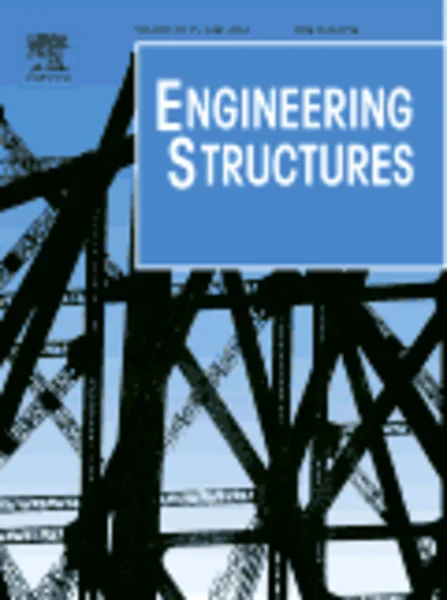-
dynamic reduction-based structural damage detection of transmission towers: practical issues and experimental verification
جزئیات بیشتر مقاله- تاریخ ارائه: 1392/07/24
- تاریخ انتشار در تی پی بین: 1392/07/24
- تعداد بازدید: 932
- تعداد پرسش و پاسخ ها: 0
- شماره تماس دبیرخانه رویداد: -
structural damage detection in large-scale three-dimensional spatial structures is a challenging problem. it is impractical to develop a general damage-detection method that is applicable to all types of structural systems and all kinds of damage. a practical and efficient structural damage detection method must consider the characteristics of the target structure and damage in the development stage. in 2009, yin et al. [33] proposed a damage detection method for the health monitoring of transmission towers. the method was developed based on the dynamical finite element (fe) model reduction technique, which utilizes identified modal parameters, such as natural frequencies and mode shapes, with only a limited number of sensors. in ref. [33], the proposed method was numerically verified by simulated noisy data from a three-dimensional transmission tower model for single and multiple damage cases. this paper discusses some practical issues related to the proposed method, such as sensor placement and computational efficiency. rather than proposing a general sensor placement method, a set of preliminary sensor locations is determined based on engineering judgement. this set of sensor locations is then checked against the results of a sensitivity analysis to ensure that the measured data contain information for identifying all of the target damage scenarios. to reduce the required computational power, two simplified versions of the proposed method are presented. the proposed method is then verified with a scaled-down model of a transmission tower (2.4 m high) that was built at the structural vibration laboratory (svl) of the city university of hong kong. this paper reports the detailed experimental setup and the method of extracting the modal parameters from a series of free vibration tests with only a limited number of sensors. the verification results show that the proposed damage detection method identifies the damaged sub-structures in all of the experimental cases considered. it must be pointed out that the transmission tower structure, in its operating conditions, suffers from the effect of the forces transmitted from the cables it carries. the influence of this force on the damage identification result is great and can not be neglected in practice. in the present experimental case study, only a transmission tower-like structure without carrying the cables is investigated in laboratory conditions.
مقالات جدیدترین رویدادها
-
استفاده از تحلیل اهمیت-عملکرد در ارائه الگوی مدیریت خلاقیت سازمانی و ارائه راهکار جهت بهبود
-
بررسی تاثیر ارزش وجوه نقد مازاد بر ساختار سرمایه شرکت های پذیرفته شده در بورس اوراق بهادار تهران
-
بررسی تأثیر سطح افشای ریسک بر قرارداد بدهی شرکت های پذیرفته شده در بورس اوراق بهادار تهران
-
بررسی تأثیر رتبه بندی اعتباری مبتنی بر مدل امتیاز بازار نوظهور بر نقد شوندگی سهام با تأکید بر خصوصی سازی شرکت ها
-
تأثیر آمیخته بازاریابی پوشاک ایرانی بر تصویر ذهنی مشتری پوشاک ایرانی (هاکوپیان)
-
مقایسه اثر آنتی میکروبیال گوتاپرکای حاوی کلسیم هیدروکساید و خمیر کلسیم هیدروکساید
-
کاربرد تبدیل موجک پیوسته در تشخیص ناهنجاری محتوای کل چگالی الکترون قائم زلزله ی اهر، ایران، 11 آگوست 2012
-
بررسی تأثیر گودبرداری بر میزان خسارت وارده به سازه های بالادست
-
استفاده از اراضی بستر رودخانه ها و منابع آبی (بر اساس قوانین و مقررات)
-
ارزیابی عملکرد شهرهای جدید ایران در جذب سرریز جمعیت مادرشهرها (مطالعه موردی: شهر جدید مجلسی)
مقالات جدیدترین ژورنال ها
-
مدیریت و بررسی افسردگی دانش آموزان دختر مقطع متوسطه دوم در دروان کرونا در شهرستان دزفول
-
مدیریت و بررسی خرد سیاسی در اندیشه ی فردوسی در ادب ایران
-
واکاوی و مدیریت توصیفی قلمدان(جاکلیدی)ضریح در موزه آستان قدس رضوی
-
بررسی تاثیر خلاقیت، دانش و انگیزه کارکنان بر پیشنهادات نوآورانه کارکنان ( مورد مطالعه: هتل های 3 و 4 ستاره استان کرمان)
-
بررسی تاثیر کیفیت سیستم های اطلاعاتی بر تصمیم گیری موفق در شرکتهای تولیدی استان اصفهان (مورد مطالعه: مدیران شرکتهای تولیدی استان اصفهان)
-
اصول طراحی زمین بازی کودکان براساس تصورات کودکانه نمونه موردی : پارک های منطقه یک شهر زنجان
-
چگونگی و حد و حصر رابطه دختر و پسر قبل از ازدواج از نظر آیات و روایات
-
جایگاه فقهی و حقوقی معاملات معارض در حقوق موضوعی ایران
-
طراحی چارچوبی برای مدیریت منابع انسانی کارآفرین محور در بخش دولتی
-
بررسی رابطه بین مدیریت سود مبتنی بر فروش دارائی های بلندمدت و وجوه نقد حاصل از عملیات در شرکت های پذیرفته شده در بورس اوراق بهادار تهران




سوال خود را در مورد این مقاله مطرح نمایید :